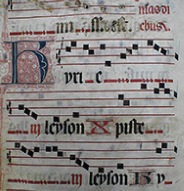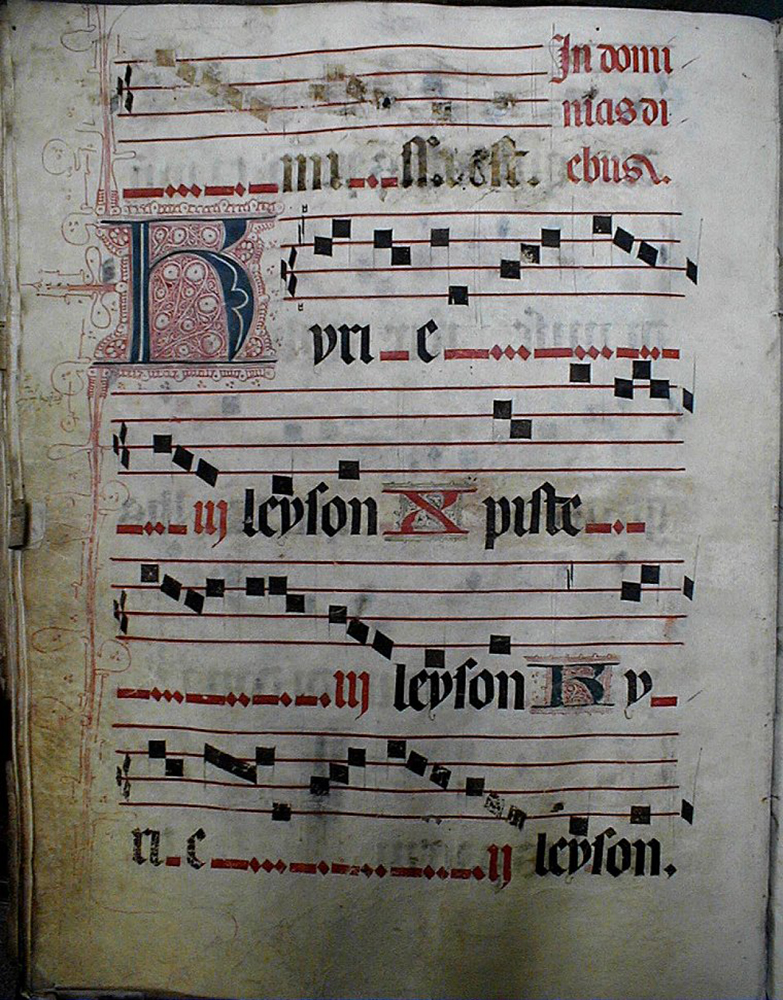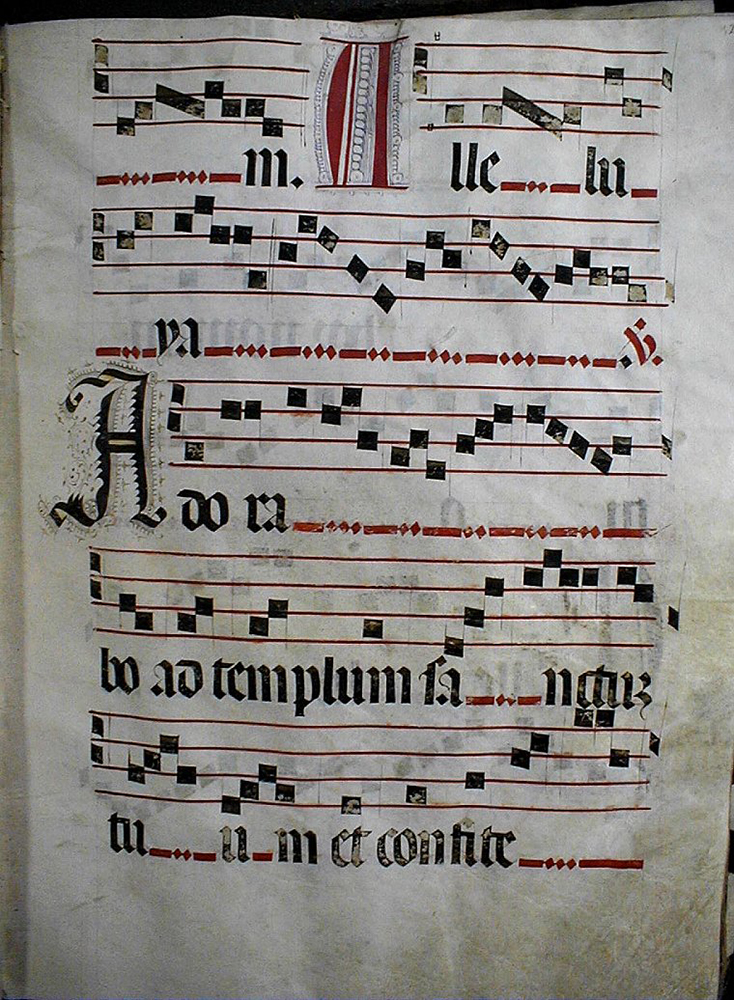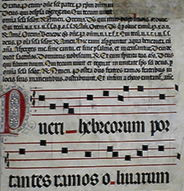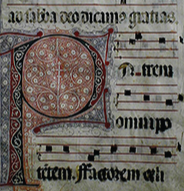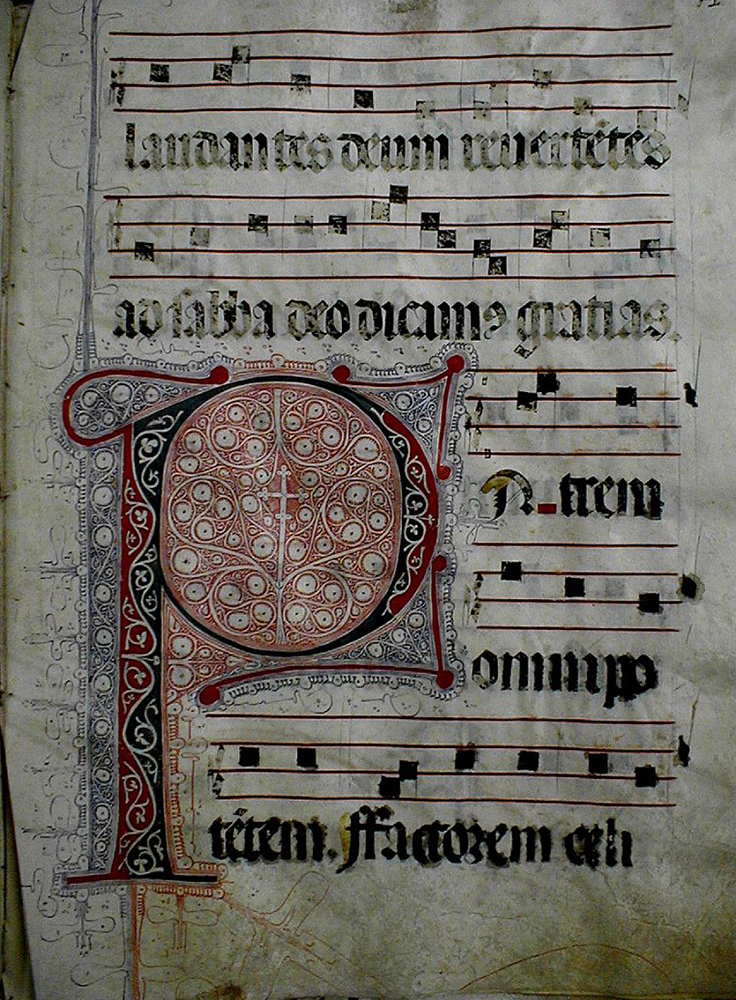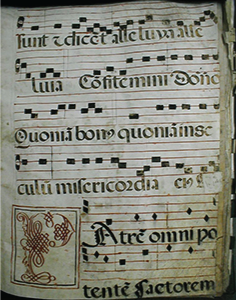The Book of Gregorian Chant
 LaBudde Special Collections at the Miller Nichols Library, University of Missouri-Kansas City, holds a book of Gregorian chant from the Middle Ages. Compiled from several sources and bound together in a single volume, the manuscript contains plainchant dating from the 10th to the 16th centuries. It was fashioned in its present form probably during the 16th century when the Medieval Latin church switched to the use of large choirbooks in its liturgy, but the book also contains original chants written by scribes centuries earlier.
LaBudde Special Collections at the Miller Nichols Library, University of Missouri-Kansas City, holds a book of Gregorian chant from the Middle Ages. Compiled from several sources and bound together in a single volume, the manuscript contains plainchant dating from the 10th to the 16th centuries. It was fashioned in its present form probably during the 16th century when the Medieval Latin church switched to the use of large choirbooks in its liturgy, but the book also contains original chants written by scribes centuries earlier.
The book contains over one hundred vellum pages bound in folio format, each page approximately nineteen inches tall and twenty-seven inches wide. The binding is covered by a leather spine and attached by heavy string to outer leather-covered wood planks nearly half an inch thick. The covers' lower edges have metal-covered corners, and a metal clasp to keep the book closed is attached to the right of the front cover by a leather strap. As a liturgical book it belongs to the same category as the Liber Usualis, a compilation of the most used chants of the Gradual (Mass) and Antiphonal (Office) along with the Missal (Mass texts) and Breviary (Office texts). Since it contains primarily chants of the Mass with few Office chants, it could loosely be labeled as a Gradual. The book's large dimensions (approximately 52 cm. high and 36 cm. wide) and the large size of its musical notation indicate, however, that it was very likely a choirbook. It definitely was used often in worship - discoloration on the bottom right of every page is evidence of the many hands who have turned the pages, and wax drippings have been found on several pages as well.
Overview
The content of the book is liturgical music and Latin texts. The bulk of the manuscript contains chants from the Ordinary of the Mass: settings of the Kyrie, Gloria, Credo, Sanctus, Agnus Dei, Ite Missa Est, Deo gratias, and Benedicamus Domino texts. Several miscellaneous chants from various Proper settings are included: the Asperges, the Requiem Mass, the Mass for the Dedication of a Church, the Mass for the Purification of Mary (Candlemas), and others. A few Office chants also appear, including chants for use for the Feast of St. Francisci, the Annunciation of the Blessed Virgin Mary (Lady Day), Maundy Thursday, and Palm Sunday. Many chant fragments also appear. A complete listing of the manuscript's contents can be found in the UMKC Library Catalog.
The manuscript's musical notation is neumatic, with black square notes appearing on red staves, which vary from four to six lines. From an analysis of notation characteristics, it appears that six scribes contributed to the book. The majority of the book is the work of "Scribe 1," including the largest illumination in the manuscript, a capital "P" which appears on folio 82 covering over half of the page. Other scribes either contributed original notation to the book, or more often, "corrected" the work of previous scribes. The methods by which these corrections were made (either by scraping the original ink off the vellum, or by painting over the original with white paint) mean that the original notes and texts can still be deciphered. Comparing the original with the new version of several chants, and then comparing those two versions with other medieval sources, was an important aide to dating the book. The manuscript's musical notation dates the book in the Medieval to early-Renaissance period. The fact that the number of staff lines varies in the manuscript from four to six lines per staff is evidence that at least part of the book was created before the staff for chant notation was standardized.
Later additions to the book, such as marginalia and a Table of Contents glued inside the front cover, indicate that it is Spanish in origin. It is known that UMKC Conservatory alumnus James Adair purchased the manuscript in Seville, Spain, in 1968. A stamp in purple ink which appears on three folios (26r, 93r, and 98r) is identified by Mr. Adair as being a Spanish government identification mark. In 1973, Mr. Adair donated the book to the UMKC Conservatory Library, which subsequently became part of the Miller Nichols Library.
This project would not have been possible without the work of Dr. Janet K. Kraybill, who studied the UMKC manuscript throughout 1999-2000 as part of her Doctor of Musical Arts degree. Dr. Kraybill's project concentrated on the musical content of the book -- analyzing the chants contained in the manuscript and drawing initial conclusions based on that research. The major result of her project is a transcription in modern notation of every chant in the UMKC manuscript. Approximately 120 pages, this transcription is a means by which today's choirs can perform the manuscript's chants. Copies of Dr. Kraybill's transcription project are held in both LaBudde Special Collections and Music/Media departments of the Miller Nichols Library.
On April 16, 2000, at the RLDS Temple in Independence, Mo., Dr. Kraybill presented a lecture-recital based on selected chants from the UMKC manuscript. She organized a male choir which sang the chants exactly as found in the manuscript. These were followed by Dr. Kraybill's performances of organ pieces based on the chants. Dr. Kraybill graciously provided a recording of the lecture-recital from which three chants were extracted and digitized by the Marr Sound Archives, the partnering audio archive of LaBudde Special Collections. These three Gregorian chants - Kyrie from the Ordinary of the Mass, Alleluia from the Mass for the Dedication of a Church, and Antiphon from the Palm Sunday celebration - have been made available for listening at this website, together with digital images of the original chants alongside Dr. Kraybill's transcriptions of them. In addition to the text for this web exhibit, Dr. Kraybill provided digital images from the manuscript. The chant transcriptions she created were scanned by LaBudde Special Collections.
Laura Gayle Green, Music/Media Reference Librarian, provided expertise and research, and Mr. Moses Ong, Special Collections volunteer and former student assistant, provided very helpful technical assistance. A special thanks to our former Special Collections Librarian, Rob Ray, for his overall guidance and support of this project.
Kyrie
The Kyrie is an acclamation sung in the Latin Mass directly after the Introit. The basic text, which is Greek, consists of 'Kyrie eleison' (three times), 'Christe eleison' (three times), 'Kyrie eleison' (three times): 'Lord, have mercy...Christ, have mercy... Lord, have mercy...'. The expression 'kyrie eleison' was widely used as an acclamation in pagan civic and religious ceremonies under the Roman Empire, and continued in Christian usage, becoming fixed in various Christian liturgies from the 6th century onwards. Since the text did not change from day to day, the Kyrie is counted a part of the Ordinary of the Mass. (Source: New Grove II Dictionary of Music and Musicians Online).
Alleluia
The Alleluia of the Mass is a Proper chant sung during the Fore-Mass after the Gradual on liturgical occasions associated with penitence and fasting (most notably during Lent), and on ones associated with sorrow (such as the Requiem Mass), when it may be replaced by the Tract. During Paschal Time, beginning with Low Sunday, the Gradual is omitted and two Alleluias are sung.
The Alleluia is performed in a responsorial manner: first the word 'alleluia' is sung, concluding with an extended melismatic flourish - the Jubilus; then a verse is chanted in a moderately elaborate setting; and finally the Alleluia is repeated. Throughout much of the Middle Ages a cantor intoned the Alleluia without its Jubilus and the chorus answered with the entire Alleluia; one or two cantors sang the verse and the chorus entered for the final word or two (usually concluding with a melisma echoing that of the Jubilus); the chorus, finally, repeated the Alleluia. Early sources fail to indicate such involvement by the chorus, but it might well be that the chorus performed at least the final repetition of the Alleluia. (Source: New Grove II Dictionary of Music and Musicians Online)
Antiphon
The Antiphon was a type of liturgial chant common to Gregorian and other Western chant repertoires and associated principally with antiphonal psalmody. It is generally a relatively short melody in a simple, syllabic style that serves as a refrain in the singing of the verses of a Psalm or canticle. There were, however, types of Antiphons not associated with psalmody at all. The processional Antiphons, first preserved in graduals and later in separate books and sung at processions on such occassions as the Feast of the Purification (Candlemas), the Greater Litanies, and Palm Sunday, sometimes included verses after the fasion of responsories. It is very likely that this particular Antiphon would have been used as a processional -- the text itself is a strong indicator. In fact, the text is still used in processionals in current services. Few Office chants exist in the UMKC manuscript. This one, from the Office of "Terce," would have been for services at 9am. (Source: The New Harvard Dictionary of Music)
Credo
From an analysis of notation characteristics, it appears that six scribes contributed to UMKC's Book of Gregorian Chant. The majority of the book is the work of "Scribe 1," including the largest illumination in the manuscript, a capital "P" which appears on folio 82r covering over half of the page (left).
Other scribes either contributed original notation to the book, or more often, "corrected" the work of previous scribes. At right is a page from the manuscript (folio 8r) by another scribe which also contains an illumination of the letter "P", but this illumination is very different in character. "Illuminations," according to Dr. Kraybill, "give distinction and beauty to this manuscript, as is typical of many medieval examples. These text decorations were created using many colors, including black, red, teal blue, dark blue, green, orange, yellow, and purple, and using many different sizes of pen. A wide variety of techniques was used, creating a range from very ornate and colorful decorations which fill the margins from top to bottom with beautiful filigree, to very crude, "colored-in" letters which seem a poor attempt by an unskilled hand to imitate the beauty of the former. These variations define the different scribes more than any other single element of the manuscript." [Kraybill, Janet Kay. UMKC's Medieval Chant Manuscript, p. 11]
Folio 82r contains the end of a hymn fragment and the beginning of Credo I (which begins with the large, illuminated "P." Folio 8r contains the last part of the Asperges Antiphon with Psalm and the first part of an unidentified Credo (which also begins with an illuminated "P").
According to the New Grove Dictionary of Music and Musicians, the Credo was the affirmation of Christian belief, sung as part of the Latin Mass between the Gospel and the Offertory. Three Latin Creeds have come down to us ('Apostles', 'Nicene', 'Athanasian'), but the history of the texts is complex; the one used at Mass is that usually called 'Nicene'. The Credo, in the so-called 'Nicene' (or 'Nicea-Constantinople') version (so called because it sums up the doctrines agreed at the Councils of Nicea, 325, and Constantinople, 381), was introduced into the eucharistic liturgy in the east early in the 6th century and soon afterwards into the Visigothic rite by the Council of Toledo (589). In both cases its introduction occurred in the wake of doctrinal controversies, and with the intent of clarifying the belief to be shared by all participating in the Eucharist. The original liturgical use of the Credo was at baptism, at a time when the articles of faith were delivered to the catechumens as part of their reception into the Church. The baptismal use of the Credo, or Symbolum as it was called in this function, lasted throughout the Middle Ages, and was incidentally responsible for the persistence of a Greek text in Latin manuscripts representing practices in northern France and Germany.
(Source: New Grove II Dictionary of Music and Musicians Online)





